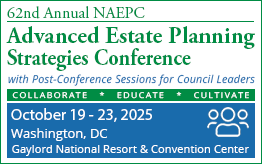August, 2007 Newsletter
Provided by Leimberg Information Services
See other issues.
Carol Cantrell's Take on Proposed Regs - A Cleaner Version
"Trustees, lawyers, accountants, and others
must now unbundle their fees to the extent they consist of unique and non-unique costs under this definition.
Once they do that, there won't be much left that is fully deductible, if anything."
Last Friday, in a FLASH release, Ron Aucutt did a great job in Estate Planning Newsletter # 1153 giving LISI members a first look at and insight into IRS proposed regs on the deductibility of fiduciary expenses.
Now Carol A. Cantrell of Briggs & Veselka Co. in Bellaire, Texas, co-counsel for the Rudkin Trust (Knight v. Commissioner of Internal Revenue), who has not only had a front row seat in this case – but who has been instrumental in driving the train – gives us her views.
And to paraphrase one of my favorite James Bond songs,
"Nobody knows it better!"
This situation has been being closely monitored for the last two years by trustees, tax preparers, bankers, and attorneys because of its implications for fiduciaries, because the federal appeals courts are divided on the question, and because the Supreme Court granted certiorari on June 25th, 2007.
Why is this proposed reg so important to every member of the estate planning team?
-
Because more than a trillion dollars in assets is estimated to be held in trusts and estates in the United States.
-
Because the fees incurred by trustees to obtain advice in investing and managing these assets are in the billions of dollars each year.
-
Because the tax treatment of these fees is of primary importance to both the beneficiaries of trusts and the financial services industry that provides investment advice.
-
Because, although the tax code clearly allows investment management fees to be deducted as administrative costs of the trust, the extent to which those fees are deductible is in hot dispute.
Here's Carol Cantrell's view:
EXECUTIVE SUMMARY:
After 21 years in hibernation and three conflicting appellate court decisions, the IRS has finally issued proposed regulations on July 26, 2007 describing which costs of an estate or trust are exempt from the 2-percent floor on miscellaneous itemized deductions under IRC § 67(e). [Prop. Reg. § 1.67-4]
The largest single component of the disputed expenses has been investment advisory fees, which the IRS classifies as subject to the 2-percent floor because they are not "unique" to an estate or trust. But the IRS has a unique definition of "unique."
Under the regulations, unique to an estate or trust means "costs that could not have been incurred by an individual property owner." This follows the holding of the Second Circuit Court of Appeals in Rudkin v. Commissioner.
Worse yet, trustees, lawyers, accountants, and others must now unbundle their fees to the extent they consist of unique and non-unique costs under this definition. Once they do that, there won't be much left that is fully deductible, if anything.
That's right! The once sacrosanct "trustee fee" that four U.S. appellate courts unanimously agree is fully deductible in all cases is now largely subject to the 2-percent floor just like all the rest of the trustee's administrative expenses.
Is this what Congress had in mind when they carved out an exception to the 2-percent floor for administrative expenses for estates and trusts under IRC Section 67(e)?
COMMENT:
But wait, all is not lost. The proposed regulations have set aside a few items on a non-exclusive list that are fully deductible because they are deemed "unique" to estates and trusts. The IRS describes these costs as "unique" - despite there being nothing unique about them and despite that the Second Circuit did not use the word unique to describe costs that it found exempt from the 2-percent floor.
The proposed regulations define costs as "unique to an estate or trust if an individual could not have incurred that cost in connection with property not held in an estate or trust." Thus, they continue the annoying habit of changing the statutory language from costs incurred by "such trust" to costs incurred by "a trust."
THE UNIQUE LIST
The following products or services are considered unique to an estate or trust because the IRS perceives that "an individual could not have incurred that cost in connection with property not held in an estate or trust":
-
fiduciary accountings
-
judicial or quasi-judicial filings required as part of the administration of the estate or trust
-
fiduciary income tax and estate tax returns
-
the division or distribution of income or corpus to or among beneficiaries trust or will contest or construction
-
trust or will contest or construction
-
fiduciary bond premiums
-
communications with beneficiaries regarding estate or trust matters
One can't help but notice what a curious combination of items appear on this non-exclusive list. They are either common expenses preceded with the label "fiduciary or trust;" they are required as part of the trust administration; or they arose solely because of the beneficiaries' differing interests. What do these items have in common?
Even more curious is the absence of legal fees, which have always been fully deductible by an estate or trust – despite the fact that individuals routinely incur them!
[EDITOR'S COMMENT:
Carol's point about legal fees is critical. Individuals frequently incur legal fees, and therefore under the proposed regulations, legal fees should now be subject to the 2-percent floor.
But the IRS has always allowed estates and trusts a full deduction for legal fees. Yes Folks – Take a look on your Form 1041s – you'll see that line 14 is dedicated to "attorney, accountant, and return preparer fees."
But now based on the proposed regs, legal fees for collecting a promissory note should be subject to the 2-percent floor, whereas fees for will or trust construction should be fully deductible.
And accountants - tax advice for items that apply generically to all individuals should be subject to the 2-percent floor, whereas advice for items that are unique to estates and trusts, such as how to comply with these new regulations should be fully deductible.]
WHAT A DIFFERENCE AN ADJECTIVE MAKES
Three of the items listed above – accountings, income tax preparation, and bond premiums – are costs that individuals routinely incur. Yet they become unique by supplying the adjective "fiduciary."
We could similarly classify investment advisory services as unique by affixing the adjective fiduciary. Yet the regulations harshly warn us not to engage in labeling games and that the classification depends on the "type of product or service rendered to the estate or trust rather than the characterization of the cost."
Hasn't the IRS violated its own regulation by characterizing a cost by its label rather than the type of product or service?
Isn't This a "But For" Test in Disguise?
The other four costs classified as unique - judicial filings, division between income and corpus, trust or will construction, and communicating with beneficiaries - are either "required as part of the administration of the estate or trust" or are incurred because of the differing interests of the trust beneficiaries. But aren't those costs simply those that were necessitated by the trustee's fiduciary duties (which O'Neill allowed) and wouldn't have been incurred "but for" the particular trustee and his duty to the beneficiaries?
Isn't that the same "but for" test advocated by the taxpayer in Rudkin v. Commissioner, which the Second Circuit resoundingly rejected?
Yet the IRS considers these costs unique to estates and trusts because it perceives that individuals cannot incur them. But that's wrong. Judicial accountings, will contests, and dealing with co-owners of split-interest property occur every day outside of an estate or trust. If simply adding the fiduciary relationship and the consequent duties to the picture, as the IRS does here, makes them unique, then why aren't costs incurred to comply with the prudent investor rule or the Prudent Investor Act unique?
The Non-Unique List
The IRS also supplied us with a non-exclusive list of non-unique products and services that are subject to the 2-percent floor on itemized deductions. They include those costs incurred in connection with:
-
custody or management of property
-
advice on investing for total return
-
gift tax returns
-
the defense of claims by creditors of the decedent or grantor
-
and the purchase, sale, maintenance, repair, insurance or management of non-trade or business property.
It is curious why gift tax returns are on this list when that cost is not typically paid by a trust or estate. But ignoring that for now, if we follow the IRS's example of supplying the magic words "fiduciary" or "income and corpus" to all the rest of the items, we can reclassify each one of them as unique to an estate or trust – fiduciary custody or management, fiduciary investing advice, defense of income or corpus, and maintenance and management of income or corpus.
Moreover, it is interesting to note that the regulations' disallowance of costs incurred for the defense of creditors' claims is contrary to the IRS's own Chief Counsel Advice 200630016, which allows a full deduction for legal, accounting, and other administrative costs incurred in connection with a bankruptcy estate under IRC § 67(e) that would not have been incurred "had the property not been held in such estate."
Treasury's Answer to Tax Simplification - Unbundling
One of the main purposes Congress announced in 1986 for enacting the 2-percent floor on miscellaneous itemized deductions was to simplify recordkeeping for individuals and prevent common taxpayer errors. It realized that many individuals "disregard[ed] the restrictions on home office deductions, and on the types of education expenses that were deductible; claiming a deduction for safe deposit expenses even if used only to store personal belongings; and deducting the cost of subscriptions to widely read publications outlining business information without a sufficient business or investment purpose." [H. Rep. No. 99-426 at 109-110 & n.8; S. Rep. No. 99-313 at 78-79 & n.18] Therefore, the 2-percent floor eliminated the need to keep track of such small expenses to the extent they likely would not exceed 2 percent of the taxpayer's adjusted gross income.
It is hard to reconcile how the regulations' requirement to unbundle trustee, legal, accounting, investment advisory, appraisal and other fees conforms to Congress's goal of simplification. Before claiming a full deduction for any administrative cost, the trustee must run each cost and each component of its fiduciary fees through a filter asking "could this cost possibly have been incurred by an individual" outside of an estate or trust?
Moreover, to the extent the trust invests in a passthrough entity, the trustee must also run each separately stated administrative item on Schedule K-1 item through the same filter to determine whether an individual could possibly incur the same type of cost on property held outside of an estate or trust, assuming they have the information to do so. If the answer is yes, the cost is subject to the 2-percent floor on miscellaneous itemized deductions under 67(e).
Most institutional trustees are not equipped to do this without reengineering their computer programs and the entire manner in which they bill for their services.
Unfortunately trust beneficiaries will bear the ultimate cost of the complexity and lost tax deductions.
What Have We Solved?
In the end, the regulation has solved nothing. It has not solved the lack of consistency among similarly situated taxpayers because the Fourth and Federal Circuits still hold that the statute unambiguously allows a full deduction for costs that are not "commonly incurred" by individuals. And in 2005 the Supreme Court in Brand X held that no interpretive regulation, such as this one, can override a US Court of Appeals interpretation of a statute that it found unambiguous because Congress left no gap for the agency to fill.
The only thing we can say with certainty is that the IRS has abandoned the "commonly incurred" test of the Fourth and Federal Circuits and the notion that trustee fees are always fully deductible as all Circuits have prescribed.
Further, we will not likely have final regulations or a Supreme Court decision by April 15, 2008. Therefore, trustees outside the Fourth Circuit that disregard the proposed regulations' interpretation can face substantial understatement penalties, unless their position is based on the weight of certain authorities enumerated in Reg.§ 1.6662-4(d)(3)(iii) or a "well-reasoned construction of the … statut[e]…" such as that advanced by the Rudkin trustee. [Reg. §§ 1.6662-3(b)(3); 1.6662-4(d)(3)(ii)] Alternatively, trustees can disclose their position on Form 8275 assuming they don't mind an IRS audit.
Return preparers can also face stiff new penalties under IRC § 6694 for signing a tax return containing a position that does not have a "more likely than not" (greater than 50-percent) likelihood of ultimately being sustained on the merits unless they have the same types of substantial authority discussed above or adequately disclose their position on Form 8275.
WHERE DO WE GO FROM HERE?
These regulations have put the taxpayer and the government about as far apart as they can be in their differing interpretations. On the one hand, most preparers claim a full deduction for costs that would not have been incurred but for the trustee's duties under the Sixth Circuit's O'Neill standard.
On the other hand, the government maintains that no cost is fully deductible unless an individual cannot possibly incur it.
The former interpretation broadly deducts almost every administrative cost except those flowing from passthrough entities.
The latter allows almost no cost to be fully deductible.
Can these warring factions ever meet in the middle without Supreme Court intervention?
I doubt it.
But in the meantime, trustees and practitioners will waste a lot of precious time and energy worrying about unbundling and commenting on these regulations before the Supreme Court ultimately decides whether they are a reasonable interpretation of the statute.
In the end, the Supreme Court is not bound by them and will alone decide whether they ever become final.
EFFECTIVE DATE:
The regulations, as proposed, apply to payments made after the date final regulations are published in Federal Register.
HOPE THIS HELPS YOU HELP OTHERS MAKE A POSITIVE DIFFERENCE!
Carol Cantrell
Edited by Steve Leimberg
CITE AS:
Steve Leimberg's Estate Planning Newsletter # 1154 (July 30, 2007) at http://www.leimbergservices.com
Copyright 2007 Leimberg Information Services, Inc. (LISI). Reproduction in Any Form or Forwarding to Any Person Prohibited - Without Express Permission.
CITES:
Prop. Reg. § 1.67-4, Fed. Reg. Doc. E7-14489 (REG-128224-06); William L. Rudkin Testamentary Trust v. Commissioner, 124 T.C. 304 (2005), aff'd 467 F.3d 149 (2nd Cir. 2006), cert. granted sub nom. Knight v. CIR (S. Ct. Doc. No. 06-1286); Mellon Bank, N.A. v. United States, 265 F.3d 1275 (Fed. Cir. 2001); Scott v. United v. United States, 328 F.3d 132 (4th Cir. 2003); O'Neill v. Comm'r, 994 F.2d 302 (6th Cir. 1993); IRC Section 67; Reg. 1.6662-4(a),(d); Chevron USA v. NRDC, 467 U.S. 837 (1984); National Muffler Dealers Assn. v. United States, 440 U.S. 472 1979; National Cable & Telecomms. Assn. v. Brand X Internet Services, 545 U.S. 967 (2005); Chief Counsel Advice 200630016; Janes, "Fiduciary Administrative Expenses: How Much Is Deductible?", 32 Est. Plan. 21, 21 (2005); Bell and King, "Sweeping Up the Two Percent Floor: Scott v. United States and the Deductibility of Investment Advisory Fees", 38 Real Prop. Prob. & Tr. J. 589, 596 (2003).
All NAEPC-affiliated estate planning councils are eligible to receive a discounted subscription rate to the Leimberg LISI service. Please see more information about the offering. You may also contact your local council office / board member to find out whether they are offering the service as a member benefit.




